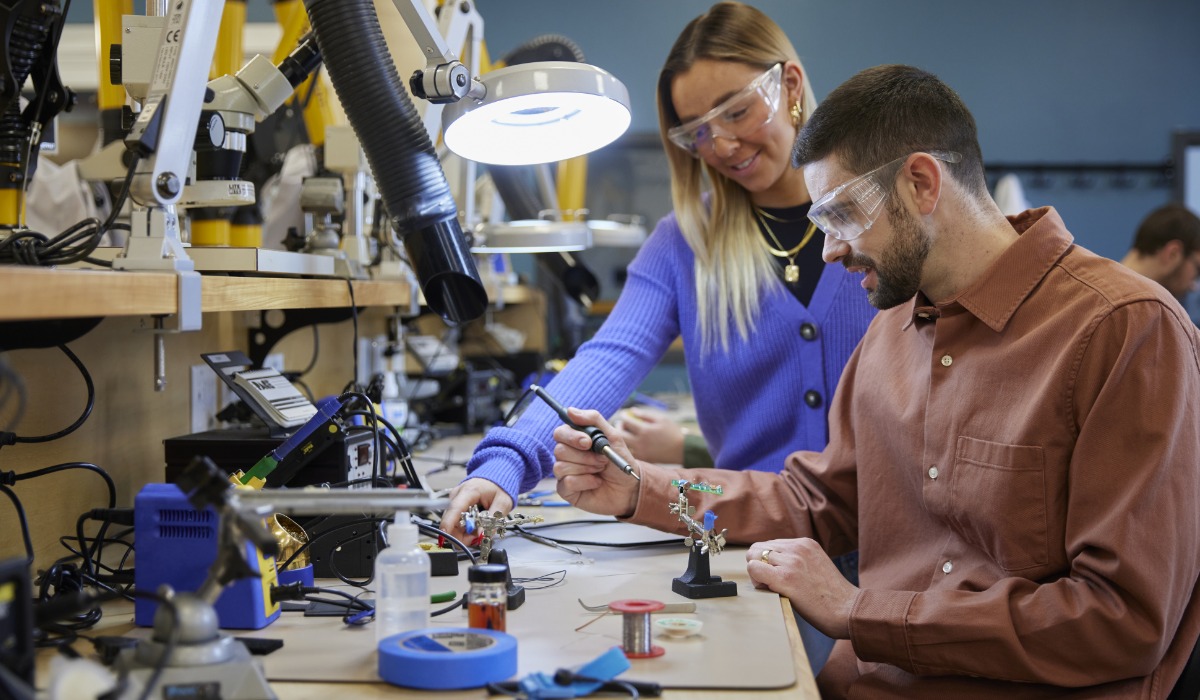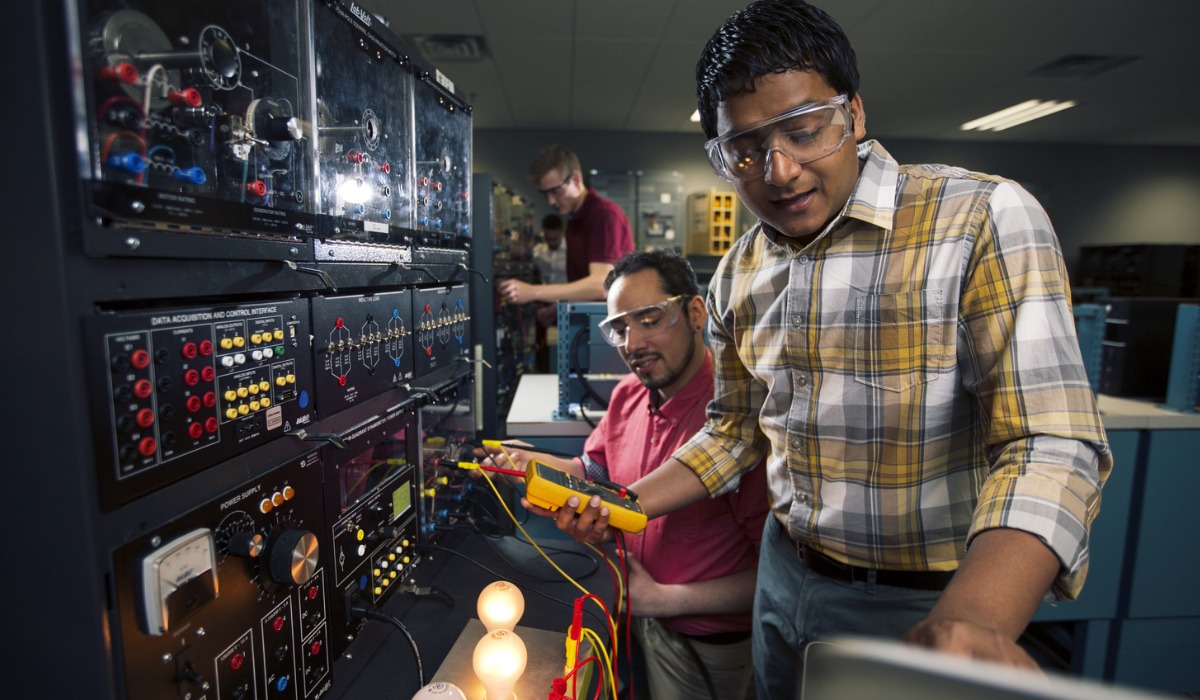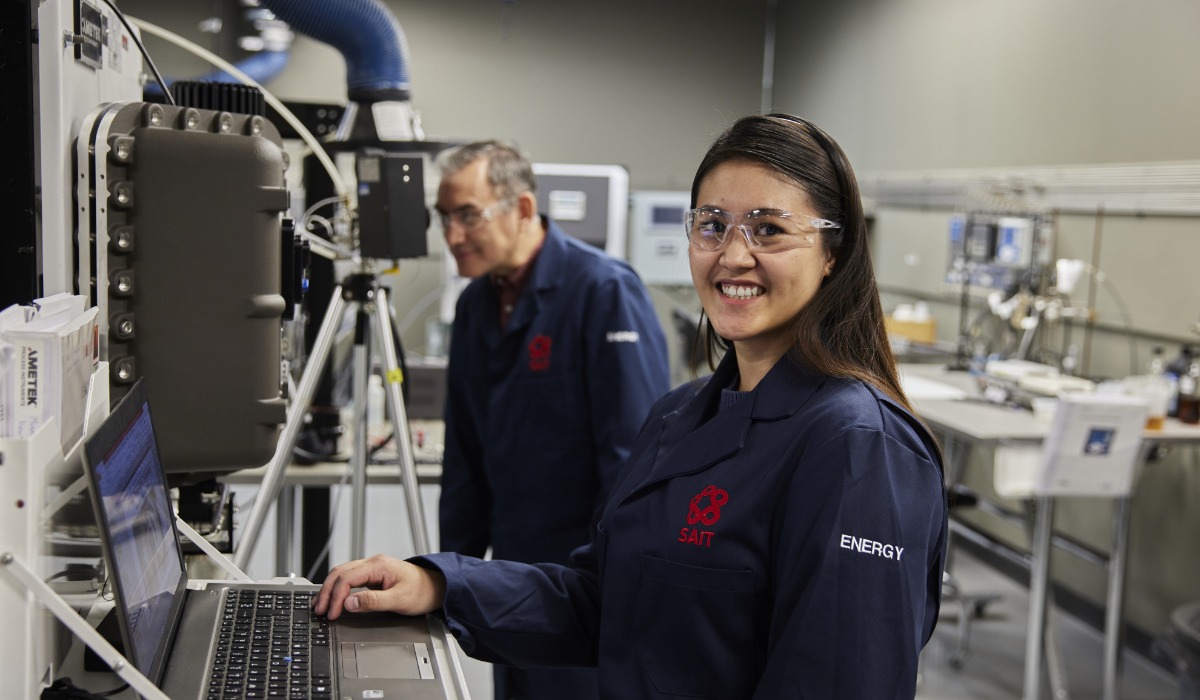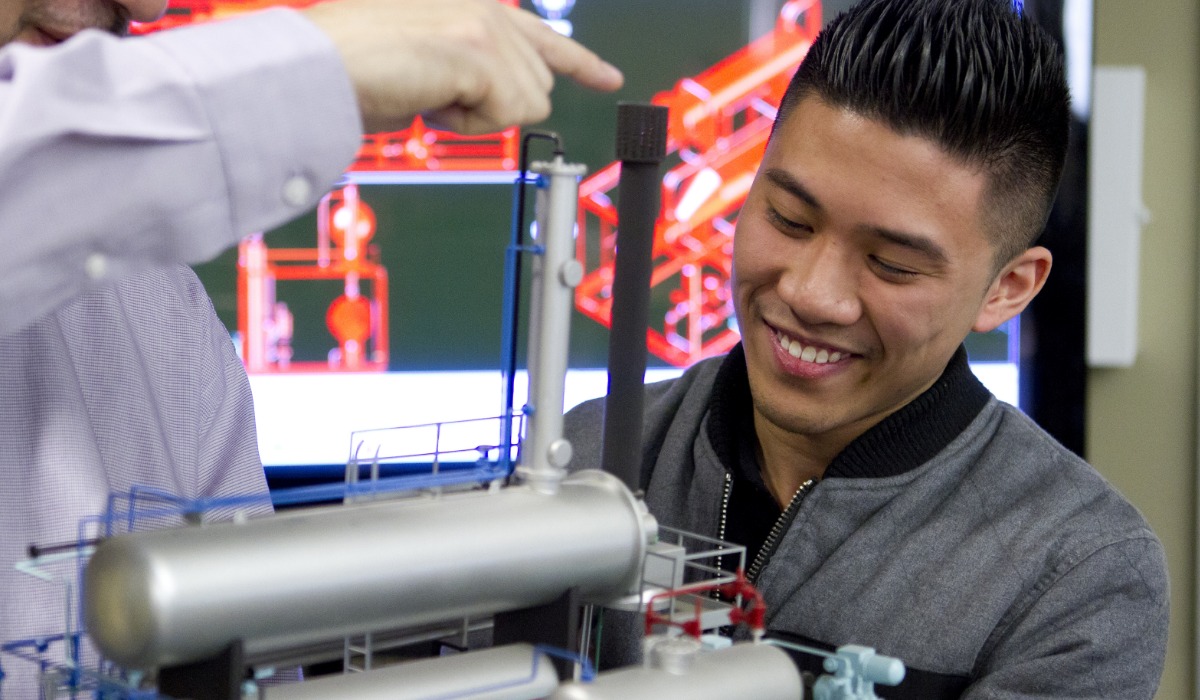Overview
Embark on a transformative journey towards becoming an electronics engineering technologist.
This program will equip you with the skills to design, analyze and troubleshoot electronic circuits and systems. Specialize in cutting-edge fields, including GPS-based systems, surveillance and wireless communication.
In this program, you will learn:
- about real-world electronic issues and innovative solutions
- to research and design
- prototyping and implementation, bringing your electronic designs to life and seeing them in action
- to master the complexities of digital and analog applications
- to command the operations of various electronic control systems
- circuit design and simulation by utilizing computer-aided tools
- to understand microprocessor systems and apply the "brains" of electronic devices, the integrated circuits that execute the functions of a central processing unit
- radiofrequency (RF) communication technologies
- computer-enhanced testing and measurement using advanced software
- to collaborate with electrical engineers on conceptual and practical circuit design tasks
- to employ a variety of analysis methods to evaluate circuit performance
- fabrication and troubleshooting with hands-on experience working alongside skilled technicians in creating and maintaining electronic systems.
Benefit from the expertise of seasoned instructors. Embrace computers and information technology with presentations and simulations that enhance understanding.
Apply theoretical knowledge in practical lab environments for a comprehensive learning experience.
After completing the program, you will be armed with the skills to make you an asset in this dynamic sector.
You could start your career as an electronic engineering technologist or technician, contributing to research and development in the industry. The program paves the way for you to continue your education and earn an electrical engineering degree with transfer options across various Canadian universities.
Electronics engineering technologists tend to be objective, innovative and methodical.
You need:
- strong communication skills
- and aptitude for math and science
- patience and persistence
- time-management and critical thinking skills
- technical problem-solving skills
- fine motor skills and hand-eye coordination
- the ability to work on a team
- the ability to meet deadlines under pressure
- an interest in continued learning.
In some positions, good colour vision is also important.
You should enjoy working with tools, equipment, instruments and machinery, finding creative solutions to problems, taking a step-by-step approach to your work and overseeing others.
In your final semester, you'll participate in a capstone project where you'll explore a problem and perform applied research to develop a proposed solution.
This program is accredited by Technology Accreditation Canada (TAC) at the Engineering Technologist level.
After two years of suitable industry experience, graduates are eligible for membership in The Association of Science and Engineering Technology Professionals of Alberta (ASET) as a Certified Engineering Technologist (CET).
After successfully completing this program, you'll receive a SAIT Electronics Engineering Technology diploma.
Careers and opportunities
Each year, SAIT conducts a survey between February and April to determine the employment rate, salary and satisfaction of our newest SAIT alumni.
![]() 88% graduate employment rate
88% graduate employment rate
Find out more about our graduate employment statistics >
Our graduates may work in the following occupations. Some careers require additional experience and education.
Associated National Occupational Classification (NOC) codes: 22310, 21310, 22311, 72011.
Career planning support
Unsure which career path is for you? Here are some recommended career planning resources to help you decide your future.
You can also head to Alberta alis for lots of information about careers in Alberta, including quizzes and labour market information to help you narrow down a path.
Finally, you can take our online career finder quiz, which can help narrow your options based on your current skills and interests.
Courses
The Electronics Engineering Technology diploma requires 60 credits (20 courses) to complete.
The program spans two years, with two semesters each year.
| Course | Credits |
|---|---|
|
Electronic Control Systems will provide learners with the tools to analyze and construct feedback control systems. This will be accomplished through the use of electronic systems to control several types of physical systems. Pre-requisites:
Corequsites:
|
3 |
|
Professional Communication and Presentation Skills will introduce learners to the professional writing, collaboration and presentation skills needed to be successful in their chosen field. Learners will gain an understanding of the strategies and competencies required for effective communication with an emphasis on developing the interpersonal skills needed to perform as part of a high-functioning team. Coursework will require learners to work in individual and collaborative settings. Equivalents:
|
3 |
|
C Programming will introduce structured programming using the 'C' language with emphasis on proper programming design. Topics will include program development, datatypes, selection statements, repetition and loop statements, bitwise, size of operations, functions, file input and output, and use of a development environment. Programs will be targeted to the engineering technology discipline. |
3 |
|
Digital Fundamentals will provide learners with a foundation of digital logic concepts. Learners will develop skills designing, building, implementing and troubleshooting basic digital logic circuits. Theory and lab will be supported through the use of simulation software. This course will prepare the learner for the Digital Design and Applications course. |
3 |
|
Digital Devices and Applications is a continuation of Digital Fundamentals. This course will develop skills in designing, implementing and troubleshooting digital logic circuits and systems. Topics will include logic circuit configurations such as counters, decoders, state machines, CPLDs and VHDL, analog to digital converters and other logic devices and applications. Learners will be prepared for Micro Fundamentals. Pre-requisites:
|
3 |
|
Electronic Fabrication will prepare learners with the skills required to build electronic projects. Learners will become skilled at component handling, reliable soldering and de-soldering for both through hole and surface mounted devices. This course will also include wiring techniques and chassis fabrication. Safety will be emphasized through WHMIS certification. Corequsites:
Equivalents:
|
3 |
|
Wireless Communications is a comprehensive course in electronic communications, from concept and general theory, through to circuit applications with an introduction to systems. Core concepts are: time versus frequency domain, analysis of signals, filtering, mixing, and analog modulation/demodulation. A detailed study of transmission lines, antennas, FM receivers, and transmitters is included. Advanced topics include frequency synthesis and tone signaling. Pre-requisites:
|
3 |
|
This hardware-oriented course prepares students to design, commission and repair modern communications systems. Students will learn advanced concepts and skills in the areas of microwave, optical, digital and data communications. Pre-requisites:
|
3 |
|
Applied Analysis will allow learners to analyze, troubleshoot, and design passive and active electronic systems with a variety of excitations. Pre-requisites:
|
3 |
|
Electronic Fundamentals will introduce students to electronic devices, circuits, and signals. Students will be able to analyze, design, and build simple circuits and test their responses to AC and DC excitation. Topics include basic circuit elements, current, voltage, power, periodic signals, basic signal measurement, and circuit analysis fundamentals. This course will prepare the learner for the Electronic Devices and Circuits I course. Corequsites:
|
3 |
|
Electronic Devices and Circuits I is a continuation of ELTR 238 Electronic Fundamentals. This course consists of the analysis, design and troubleshooting of circuitry containing diodes, bipolar junction transistors and various field-effect devices. This course will prepare the student for Electronic Devices and Circuits II. Pre-requisites:
Corequsites:
|
3 |
|
This course is a continuation of Electronic Devices and Circuits I and will cover a variety of topics in analog electronics with an emphasis on operational amplifiers and linear integrated circuit design. Topics include linear amplifiers, comparators, oscillators, linear power supplies, and class A/B power amplifiers. Pre-requisites:
|
3 |
|
This course builds on the foundational principles of business operations in the Information Technology field with emphasis on entrepreneurship and data-analytics. Students will also employ organizational effectiveness strategies within the context of a project team in a variety of business scenarios. |
3 |
|
INST 302 addresses metrology concepts in electronic test instrumentation. Students will use LabView and Signal Express with the IEEE-488 and DAQ acquisition interface. Students will design a computer automated test system using electronic instrumentation. Pre-requisites:
Corequsites:
|
3 |
|
Mathematics for Technologists will provide learners with concepts in algebra, trigonometry, arithmetic of complex numbers, linear algebra, exponential and logarithmic functions, rates of change and statistics. This course provides foundational mathematics skills for engineering technologists. It covers a variety of mathematical models for solving application problems. |
3 |
|
Calculus for Technologists, a continuation of the Mathematics for Technologists, provides learners with required skills for calculus. Following an introduction to continuity and limits of functions, topics will include general rules of differentiation and of integration for algebraic and transcendental functions as well as topics in infinite series. The general rules studied will be applied to solve application problems. Pre-requisites:
|
3 |
|
In this course, learners are introduced to the fundamentals of RISC microprocessor core architecture and programming using CrossWorks for ARM Integrated Development Environment (IDE). This is followed by an in-depth look at an ARM Cortex-M4 processor based micro-controller, specifically the STM32F405RG. Learners will also be introduced to microprocessor architecture, hardware, and program design using the assembly language and C. Specific software designs include interfacing peripherals such as GPIO, LCD driver, keypad interaction, and serial communications using USART, I2C, and SPI. Pre-requisites:
|
3 |
|
In this course, learners will apply basic skills and knowledge acquired in MCRO 310 to the more advanced topics required in embedded systems design and applications. Focus is placed on interfacing devices with timers, PWM, DAC, ADC, and RTC. An in depth analysis of exception/interrupt handing of the ARM Cortex-M processor family is provided. Learners will also be introduced to some advanced concepts in embedded system designs such as DMA, digital filtering, real-time operating systems, and SCADA. Pre-requisites:
|
3 |
|
The successful completion of an electronics-based project requires that the individuals and/or the development team work closely with project stakeholders. Students will plan the project, execute according to plan, and solve problems efficiently. This course focuses on fundamental principles of both project management and requirements engineering. Students will use software tools to support a project and to create a printed circuit board. Pre-requisites:
|
3 |
|
The capstone project course requires students to execute a project plan, that is based on an issue of personal or professional interest, that will address the problem or issue through applied research. The capstone project course requires students to demonstrate an integration of Electronics Engineering Technology (ENT) technical skills and knowledge, professional competencies and development/execution strategies. Pre-requisites:
|
3 |
Progression
You must attain a PGPA and/or a CGPA of 2.0 or better each semester and pass the prerequisite courses to progress through the program.
To qualify for graduation, you must pass all courses, attain a CGPA of 2.0 or better and complete course requirements within the prescribed timelines.
Review our grading and progression procedure >
Explore your options!
Some courses in this program are available through Open Studies. You can complete courses via Open Studies to get a head start on your education, reduce your course load once accepted into a credentialed program, or determine which career path best suits you before you fully commit.
You may also take courses for general interest or personal and professional development.
Admission requirements
Applicants educated in Canada
All applicants must demonstrate English language proficiency and meet all of the following requirements or equivalents:
- at least 60% in Math 30-1 or 75% in Math 30-2, and
- at least 60% in English Language Arts 30-1 or English Language Arts 30-2, and
- at least 60% in Physics 20.
SAIT accepts high school course equivalents for admission for applicants educated outside Alberta.
All applicants who were educated outside of Canada must demonstrate English language proficiency and provide proof they meet the program admission requirements outlined above with an international document assessment. Find accepted educational documents and assessment options.
SAIT may also accept courses completed at certain international post-secondary institutions.
Academic Upgrading
Missing an admission requirement for this program? Upgrade your prior education to help you receive admission into one of SAIT's career programs.
English language proficiency
All applicants must demonstrate English language proficiency prior to admission, including students educated in Canada.
Transfer agreements
At SAIT, we have created transfer agreements with partner institutions to allow you to earn course credits toward your SAIT program based on your previously completed credentials.
Transfer Alberta search tool
Use the Transfer Alberta search tool to see all transfer agreements between Alberta post-secondary institutions (including those with the University of Calgary, Mount Royal University and Bow Valley College.)
Search transfer agreements in Alberta
Transfer options for graduates
When you have completed this program, you may continue your education at a partner post-secondary institution. These transfer agreements include partnerships within and/or outside of Canada.
Credits this program transfers to
- Available credits:
- 60
Graduates of this program are eligible to apply for the Electrical and Computer Engineering bridge program offered by Camosun College, provided all admission requirements are met.
Successful completion of this bridging program will qualify you to enter the third year of the Bachelor of Engineering in Electrical Engineering (January intake) at the University of Victoria. This degree is eligible for Professional Engineering (P.Eng.) designation.
- Available credits:
- 60
Graduates of this program are eligible to apply for the Electrical and Computer Engineering bridge program offered by Camosun College, provided all admission requirements are met.
Successful completion of this bridging program will qualify you to enter the third year of the Bachelor of Engineering in Computer Engineering (January intake) at the University of Victoria. This degree is eligible for Professional Engineering (P.Eng.) designation.
- Available credits:
- 57
Upon successful completion of this program, you can ladder into the third year of TRU's Open Learning Bachelor of Technology program, provided you meet the admission requirements.
- Available credits:
- 60
Upon successful completion of this program, you can ladder into the third year of TRU's Open Learning Bachelor of Technology: Trades and Technology Leadership program, provided you meet the admission requirements.
Available intakes
Fall 2026
Start dates:
- Domestic students: Open
-
-
Application deadline: June 30, 2026
-
- International students: Open
-
-
Application deadline: May 29, 2026
-
Winter 2027
Start dates:
- Domestic Students (apps open March 1, 2026): Closed
-
-
Application deadline: Oct. 23, 2026
-
- International students: Open
-
-
Application deadline: Oct. 9, 2026
-
Costs
2025/26 tuition and fees
The following costs are effective as of July 1, 2025.
The estimated total cost of tuition and fees is based on the suggested schedule of study. Following a modified schedule will impact the fees you pay per semester and may alter final costs.
Domestic students
The program total is based on the estimated amount you will pay if you enter this program during the 2025/26 academic year. The program total amount listed on your letter of admission may appear higher. This amount is your maximum tuition guarantee for the program. SAIT will not exceed this maximum, regardless of changes in tuition and fees between academic years.
Books and supplies are approximately $1,000 - $1,500 per full-time year.
This is a bring-your-own-device program with a standard computer hardware and software requirement. See the specific requirements on our computers and laptops page.
Find your booklist on the SAIT Bookstore's website. The booklist will be available closer to the program start date. Can't find your program or course? The bookstore didn't receive a textbook list. Contact your program directly to determine if they're still refining course details or if you're in luck; no textbook purchase is required this term.
Required personal protective equipment (PPE)
The industry-approved PPE you'll need will be discussed during your first few days of classes.
Required tools and equipment
A small electronics parts kit will be required in your fourth semester. These will be available for purchase through the SAIT Bookstore.
Financial aid
Paying for your education may feel overwhelming, but we have resources and programs that can help, including information about payment options, student loans, grants and scholarships.
Application process
Ready to apply?
Follow our step-by-step guide to submitting a successful application.
Communication during admission
Email is the primary source of communication during the selection process. Ensure your personal email account is managed appropriately to receive our emails, files and communications. We recommend you add the macphail.students@sait.ca domain to your safe senders' list or you risk missing critical email messages.
Begin your application
Apply now using the online application portal.
Ensure you have a valid Visa or Mastercard to pay the non-refundable application fee of $120 for domestic applicants or $175 for international applicants.
Information sessions
Prepare for a strong start in your chosen program or get the details you need to decide your future path.
Our expert staff and faculty are ready to answer your questions and provide information about the following:
- What sets SAIT apart
- An introduction to the program and area of study
- Admission requirements
- Future career paths
- Information on the earning potential and graduate employment rates.
Contact us
MacPhail School of Energy
-
Phone - 403.284.8451
International Student Advising
-
Phone - 403.284.8852
-
Email - international@sait.ca
Subscribe for updates
Your journey starts here! Sign up to get important updates on:
- Energy and environment programs
- Application information
- Relevant news and events

Oki, Âba wathtech, Danit'ada, Tawnshi, Hello.
SAIT is located on the traditional territories of the Niitsitapi (Blackfoot) and the people of Treaty 7 which includes the Siksika, the Piikani, the Kainai, the Tsuut’ina and the Îyârhe Nakoda of Bearspaw, Chiniki and Goodstoney.
We are situated in an area the Blackfoot tribes traditionally called Moh’kinsstis, where the Bow River meets the Elbow River. We now call it the city of Calgary, which is also home to the Métis Nation of Alberta.




